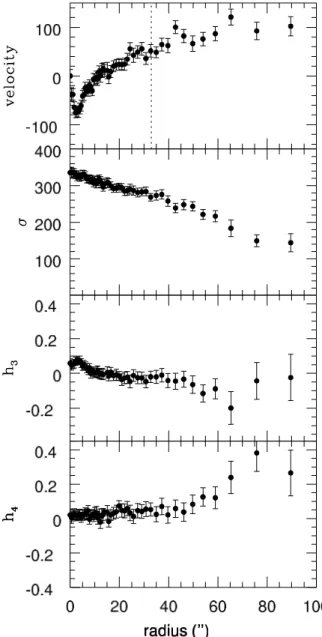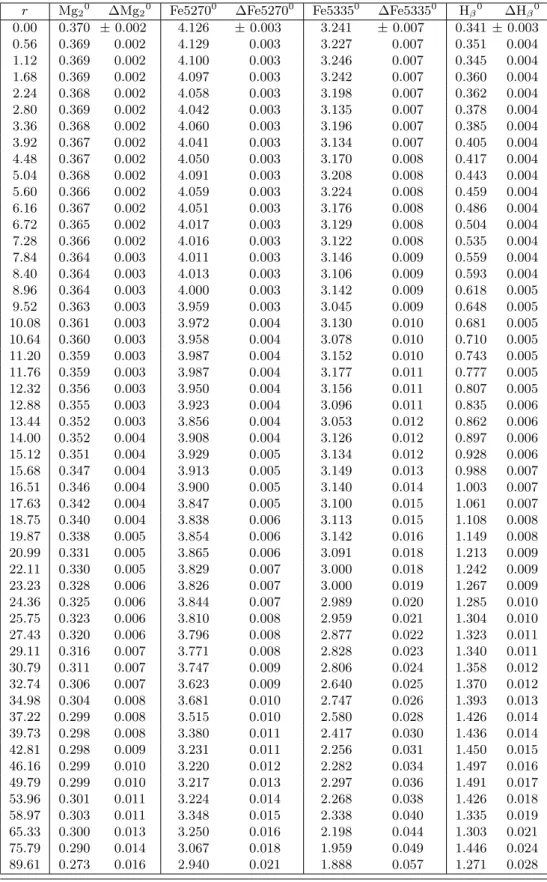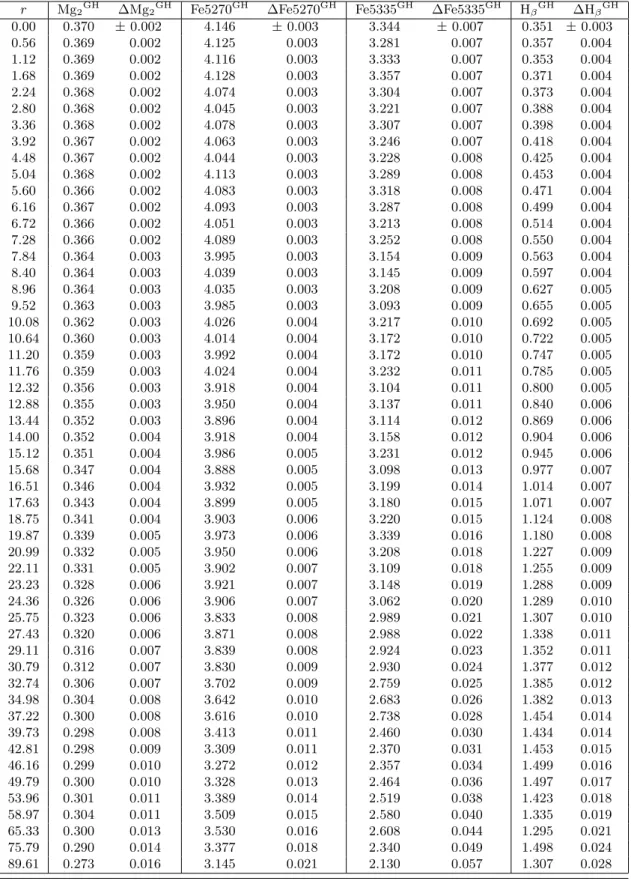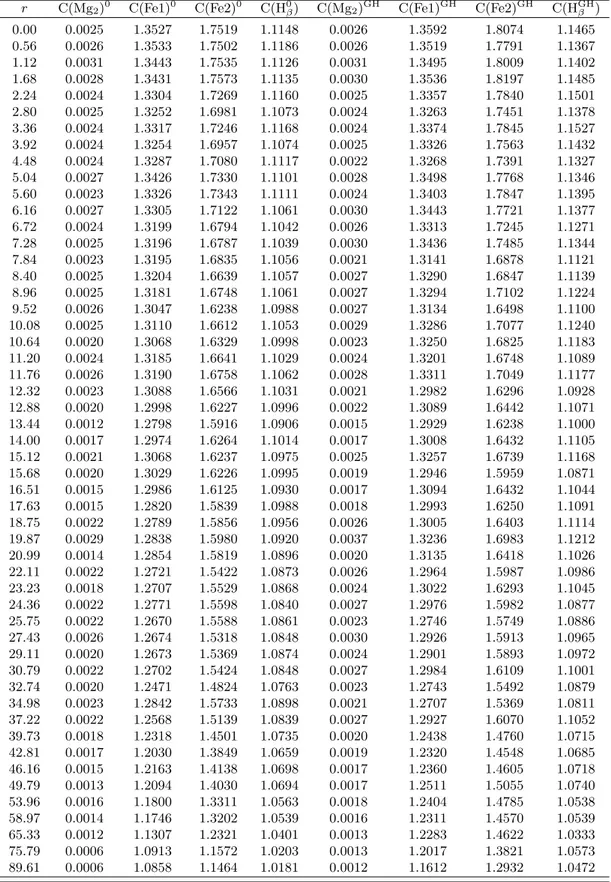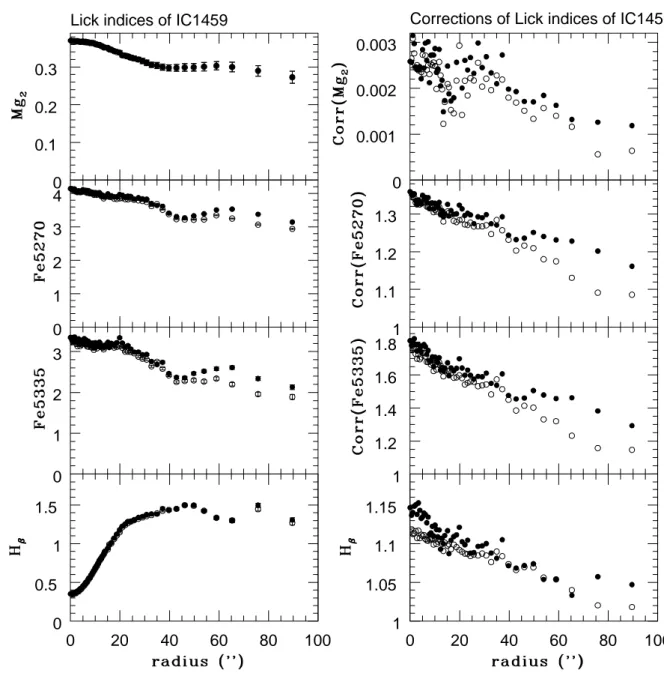MEASUREMENT OF THE LICK INDICES IN
EARLY-TYPE GALAXIES: LINE-OF-SIGHT VELOCITY
DISTRIBUTION CORRECTIONS FOR IC 1459
S. Samurovi´c
Astronomical Observatory, Volgina 7, 11060 Belgrade 38, Serbia
E–mail: srdjan@aob.bg.ac.rs
(Received: July 13, 2009; Accepted: August 4, 2009)
SUMMARY: In this paper we analyse the measurements of the absorption line-strength Lick indices in the early-type galaxy IC 1459. We use the long-slit spectra of the elliptical galaxy IC 1459 from which its kinematics had previously been extracted to calculate the Lick indices for the observed spectral region (Mg2, Fe5270, Fe5335
andHβ). We apply the usual procedure and correct the indices to the Lick spectral resolution and for the zero velocity dispersion. The procedure applied in this paper also corrects to non-Gaussian line-of-sight velocity distribution (LOSVD) observed in this galaxy, especially in its outer parts. The findings of Kuntschner (2004) were tested and it is shown that the departures from the Gaussian LOSVD may indeed cause erroneous determinations of the Lick indices. The impact of the introduction of non-Gaussian LOSVD differs for different indices. For the galaxy IC 1459 it is shown that the iron indices are especially sensitive when the correction due to anistropies is introduced: the corrections for Fe5270 and Fe5335 are∼10and∼19 percent larger, respectively, than the corrections obtained in case of a pure Gaussian. The corrections for Mg2 index are shown to be negligible and the corrections of
the Hβ index due to anisotropies are also small (below∼4per cent at most).
Key words. Line: profiles – Methods: data analysis – Galaxies: elliptical and lenticular, cD – Galaxies: kinematics and dynamics – Galaxies: individual (IC 1459)
1. INTRODUCTION
In 1972 S. Faber and her collaborators started a long-term spectroscopic project that was aimed at the study of stellar populations in globular clusters and early-type galaxies. For this purpose theImage Dissector Scanner (IDS) on the Shane 3m tele-scope of Lick Observatory was used. Faber and col-laborators observed a large number of galaxies, and stars of all types, field and cluster giants, subgiants
and dwarfs in the spectral range from ∼ 4000 ˚A to
∼ 6200 ˚A with a ∼ 8.6 ˚A FWHM resolution. The Lick group defined and measured spectral indices to monitor the strength of spectral features in stars and galaxies (see Faber et al. 1985). Note, however, that since the early papers of the Lick group the wave-length accuracy has improved and new definitions are now valid. All the calculations presented below were based on the updated version of the indices ta-ble taken from the WWW site of G. Worthey.1
Table 1: Definitions of indices calculated in this paper
Name Index band [˚A] blue continuum [˚A] red continuum [˚A] Units Hβ 4847.875 4876.625 4827.875 4847.875 4876.625 4891.625 ang
Mg2 5154.125 5196.625 4895.125 4957.625 5301.125 5366.125 mag Fe5270 5245.650 5285.650 5233.150 5248.150 5285.650 5318.150 ang Fe5335 5312.125 5352.125 5304.625 5315.875 5353.375 5363.375 ang
NOTE: Units: ”mag” refers to the index measured in magnitudes, and ”ang” refers to the index measured in Angstroems.
In order to define an index one should define a central band of width ∆0and two side bands. The ”side-band level”Isis defined to be the mean inten-sity over the two side bands, and the inteninten-sity of the central feature Ic is the mean intensity in the cen-tral band. There are two groups of indices: one is measured as an equivalent width (for example, iron indices):
w=
µ
1−Ic
Is
¶
∆0
and the other is measured in magnitudes (for exam-ple Mg2):
w=−2.5 log
µ
1−Ic
Is
¶
.
The spectra that we used were centered at
∼5150 ˚A to be near the Mg2 feature and the range was∼700 ˚A. The indices we have measured are given in Table 1 (for a full list of definitions the reader is referred to the WWW site of G. Worthey).
This paper addresses the measurements of the Lick indices. For the application and modeling of these quantities the reader is referred to abundant literature (see e.g. Trager et al. 2000a,b, Thomas, Maraston and Bender 2003). The plan of the paper is as follows: in Section 2 we present the kinemat-ics of IC 1459, because it is of crucial importance for the task of this work; in Section 3 we explain our measurement procedure and introduce the cor-rections which we apply; in Section 4 we present our results and, finally, in Section 5 we discuss the ob-tained results and draw the conclusions.
2. KINEMATICS OF IC 1459
IC 1459 is a giant E3 elliptical galaxy. It cov-ers 5.2×3.8 arcmin on the sky (RC3). Its heliocentric radial velocity is 1663±74 km s−1 (taken from the LEDA database) which means that, using the Hub-ble constant equal to 70 km s−1Mpc−1, one arcsec in this galaxy corresponds to∼117.16 pc. The effective radius of IC 1459 is 33′′(= 3.87 kpc). The absolute blue magnitude of IC 1459 is−20.52. This galaxy has some peculiar features: a fast counterrotating stellar core (Franx and Illingworth 1988), twisted isophotes (Williams and Schwarzschild 1979), dust lanes and
patches near the nucleus (Sparks et al. 1986) and an ionized gaseous disk at the core that rotates along the major axis in the same direction as the majority of stars in the galaxy (opposite to that of the stellar core) (Forbes et al. 1995).
IC 1459 was observed by J. Danziger on Au-gust 28-30 1997 using the ESO NTT and EMMI in the Red Medium Spectroscopy mode. The ma-jor photometric axis of this galaxy was observed and integrated stellar long-slit spectra were taken. The observational details are given in Samurovi´c and Danziger (2005) and we here only briefly remind the reader that the data reduction was performed in the MIDAS2environment and the extraction of kinematics was done using ”Gauss-Hermite Fourier Fitting soft-ware” (described in van der Marel and Franx 1993). Before we present the observational results we briefly explain the meaning of the measured kine-matical parameters. First, we introduce the func-tion which describes line-of-sight velocity distribu-tion (LOSVD, also called velocity profile, VP). This function defines the fraction of the stars that con-tribute to the spectrum which have LOS velocities between vLOS and vLOS +dvLOS and is given as
F(vLOS)dvLOS. If one assumes that all stars have identical spectra S(u) (where u is the spectral ve-locity in the galaxy spectrum), then the intensity that is received from a star with LOS velocityvLOS isS(u−vLOS). Summing over all stars one gets:
G(u)∝
Z
dvLOSF(vLOS)S(u−vLOS), (1)
where G(u) is the galactic spectrum. Up to 1993, a purely Gaussian form of the LOSVD was used. How-ever, van der Marel and Franx (1993) and Gerhard (1993) showed that the LOSVD can be modeled more accurately as a truncated Gauss-Hermite (FTGH) se-ries consisting of a Gaussian multiplied by a polyno-mial:
FTGH(vLOS) = Γ
α(w) σ " 1 + n X k=3
hkHk(w) #
. (2)
Here Γ represents the line strength, w ≡ (vLOS − ¯
v)/σ,α≡ 1
√
2πexp(−w
2/2), where ¯vandσare free
Table 2: Stellar kinematics of IC 1459. We show velocity, velocity dispersion and the Gauss-Hermite parametersh3 andh4 with their observational errors.
r v[km s−1] ∆v σ[km s−1] ∆σ h3 ∆h3 h4 ∆h4
parameters; hk are constant coefficients and Hk(w)
is a Gauss-Hermite function, that is a polynomial of order k. We truncate the series at k = 4 thus tak-ing into account the h3 and h4 parameters. With these expressions, the LOSVD can be calculated by varying the values of ¯v,σ,h3andh4until the convo-lution of the function FTGH(vLOS) with a template star spectrum best reproduces the observed galaxy spectrum. The optimal fit is obtained using a non-linear least-squares fitting algorithm. If the form of the LOSVD is close to the Gaussian form, then ¯
v and σ will be approximately equal to ¯vLOS and
σLOS. Parametersh3 andh4 are important because they measure asymmetric and symmetric departures from the Gaussian, respectively. If one detects a positive (negative) value of the h3 parameter, that would mean that the distribution is skewed towards higher (lower) velocities with respect to the systemic velocity. On the other hand, if one detects h4 > 0, this means that the distribution is more peaked than the Gaussian at small velocities with more extended high-velocity tails (the radial orbits dominate); for h4<0 the distribution is more flat-topped than the Gaussian (the tangential orbits dominate).
In Table 2 and Fig. 1 we present the kine-matical profile for the major axis of IC 1459 because it is of importance for the discussion that follows. Note that we assume symmetry about the y-axis and, therefore, we folded all the observational data (ve-locity, velocity dispersion and the Gauss-Hermite pa-rameters,h3andh4), taking into account that veloc-ity andh3parameter are odd functions while velocity dispersion and h4 are even functions of the radius. The aforementioned fast counterrotating stellar core is clearly visible in the innermost regions of IC 1459 (top panel).
The galaxy IC 1459 is a very interesting case because it shows departures from the Gaussian be-yond ∼ 1Re with rather large values of the h4 pa-rameter, which suggests radial orbits in the outer-most regions. The purpose of the present study is to quantify the influence of the observed anisotropies in the stellar motion on the measured Lick indices.
3. MEASUREMENTS OF THE LICK INDICES
We measured the line strength indices using the procedures we have written in FORTRAN which we embedded in theMIDASscripts. We relied on the AVINTroutine by Davis and Rabinowitz (1984) that was included in the SLATEC library of programs3. This routine, based on overlapping parabolas, calcu-lates the integral
b Z
a
f(x)dx (3)
whenf(x) is tabulated in nonequally spaced abscis-sas – this is the most general case: in our calculations abscissas were equally spaced. To verify the results, we tested the routine using some elementary func-tions and also some standard spectra obtained from the site of G. Worthey, and the agreement was ex-cellent with the elementary functions and very good in the case of the Worthey’s spectra. The obtained results confirmed that our procedure is suitable for the extraction of the Lick indices from the long-slit spectra.
The routines we have written were used on the deredshifted spectra, and the measurements were standardized to a Lick system. Two usual steps
Fig. 1. Stellar kinematics of IC 1459 for the major axis. From top to bottom: velocity, velocity disper-sion, h3 andh4 parameters. One effective radius is
marked in the top panel by a vertical dashed line.
necessary to transform the spectra into the Lick sys-tem (see for example Fisher, Franx and Illingworth 1995, Gonzales 1993, Halliday 1998) are:
• correction to the Lick IDS spectral resolution (∼8.2˚A at∼5200 ˚A) and
• correction to zero velocity dispersion.
Kuntschner (2004) suggested that the Lick in-dices are sensitive to the LOSVD corrections to non-Gaussian LOSVDs, and assumed that LOSVD can be described by the Gauss-Hermite series decribed above. He then calculated the corrections of the in-dices due to anisotropies, assuming givenfixedvalues of theh3andh4parameters (he took: |h3| ≤0.2 and |h4| ≤ 0.2 taking into account all possible combi-nations but presented results only for |h3| and |h4| which vary out to 0.1 ). The following question how-ever remains: How to calculate the Lick indices when we encounter different (i.e. not tabulated by Kun-schner (2004)) values of the h3 and h4 parameters? This is the case of IC 1459 for which we have mea-sured these paramaters out to ∼ 3Re and we see
in Table 1 that different combinations of parame-ters are possible; we also note that the|h4| parame-ter may takemuch highervalues than 0.1 presented by Kuntschner; see his Figs. 7 and 8. This is the reason for which we decided to write a procedure which calculates the corrections of different Lick in-dices assuming different values of velocity dispersion and Gauss-Hermiteh3 andh4 parameters. The pro-cedure is written in theIDL4programming language and its algorithm is described below. Therefore, we list here the third correction to be applied in order to measure the Lick indices:
• correction to non-Gaussian LOSVD.
The first correction is related to the differ-ent spectral resolution of our observations and those of the Lick IDS. The spectra of the Helium-Argon calibration lamp were inspected to measure the in-strumental resolution and then the galaxy frame was broadened so as to match the Lick spectral resolution (∼8.2 ˚A at ∼5200 ˚A).
The second correction for the effects of the velocity dispersion included the following steps: the spectra of the template star (the star HR2701 was observed with the same observational setup in the same nights as the galaxy IC 1459) were broadened for a given velocity dispersion at a given position (for example at 0 .′′56 the stellar spectrum was broadened withσ= 336.161 km s−1 which is the maximal ve-locity dispersion encountered in this galaxy) always assuminga pure Gaussian function (i.e. h3=h4 ≡ 0.0).
Following the paper of Carollo, Danziger and Buson (1993), the estimate of the errors (given in Table 3 and Fig. 2) for the indices (I) was calculated using:
ǫi= r
OBJ + 2×DK +³1 +Nrows1 ´×SKY + ron2
OBJ ,
(4)
where OBJ is the total count in the object, SKY is the total count in the sky, DK is the total count in dark, and ron is the read-out noise of the CCD. The term Nrows1 comes from the subtraction of a sky aver-aged on Nrows(=30) rows from the galactic spectra. One can now define the error on the line-strength index:
∆I= coeff×
s X
i=c1,c2,b ǫ2
i,
wherec1,c2andbindicate respectively the two con-tinua and the index band. The coefficient is equal to 1.08(= −2.5log e) for the Mg2 index and to
(Cfeat×Wpix)
Ccont for the atomic indices (Fe5270, often ab-breviated to Fe1; Fe5335, often abab-breviated to Fe2; and Hβ);Cfeatis the total count in the feature,Wpix is the pixel width in ˚A, andCcont is the average con-tinuum.
Then a correction factor (which we callC0(σ) in the following because being taken for the pure Gaussian function) is calculated by comparing each broadened spectrum with a measurement for the original unbroadened stellar spectrum. In the case of the molecular index Mg2, the correction factor is defined as a difference between the measurement of the original unbroadened stellar spectrum and that of the spectrum broadened to a particular velocity dispersion:
C0(σ) =Iorig−I0(σ). (5)
For the atomic indices, the correction factor is de-fined as the ratio between the original and the smoothed (with a pure Gaussian) line indices:
C0(σ) =I
orig/I0(σ). (6) Here (and also below when we deal with a modified Gaussian) ”I” stands for index and the original un-broadened index is denoted with ”orig”. Since the bands are wide, the corrections for Mg2 are very small. On the contrary, the corrections for the iron indices and Hβ can be significant. When the
correc-tions are taken into account and applied to a galactic spectrum, we obtain the values of different indices given in Table 4 and Fig. 2 (open circles).
Finally, the third correction is due to non-Gaussian LOSVD observed in the galaxy IC 1459. To apply the aforementioned IDL routine it is nec-essary to have the full kinematical profile of a given galaxy (velocity dispersion, and the Gauss-Hermite parameters h3 andh4). The procedure is analogous to that applied in the case when we assume a pure Gaussian function, but with the inclusion of the mea-sured non-zero values of the Gauss-Hermite h3 and
h4 parameters. This, for example, means that at the last measured point of IC 1459 we broaden the template star spectrum by σ = 144.155 km s−1,
h3 =−0.024 and h4 = 0.266 and calculate the cor-rection in an analogous way as earlier but instead of Eqs. (5) and (6) we now use for the molecular Mg2 index:
Table 3: Lick indices of IC 1459 corrected for Lick resolution and velocity dispersion assuming a pure Gaussian function. For each index, the observational errors are also given.
r Mg20 ∆Mg20 Fe52700 ∆Fe52700 Fe53350 ∆Fe53350 Hβ0 ∆Hβ0
Table 4: Lick indices of IC 1459 corrected for Lick resolution and velocity dispersion taking into account non-zero Gauss-Hermite parameters. For each index, the observational errors are also given.
r Mg2GH
∆Mg2GH
Fe5270GH
∆Fe5270GH
Fe5335GH
∆Fe5335GH
HβGH ∆HβGH
Table 5: Corrections of the Lick indices of IC 1459. Note that in this table ”Fe1” and ”Fe2” were used for Fe5270 and Fe5335 indices for brevity, respectively. The superscript ”0” is written when a pure Gaussian is used, and the superscript ”GH” is used when the corrections due to non-zero values of the Gauss-Hermite parameters were taken into account. See text for details.
r C(Mg2)0
C(Fe1)0
C(Fe2)0 C(H0
β) C(Mg2)
GH
C(Fe1)GH
C(Fe2)GH
C(HGH
β )
0
0.1
0.2
0.3
Lick indices of IC1459
0
1
2
3
4
0
1
2
3
0
20
40
60
80
100
0
0.5
1
1.5
0
0.001
0.002
0.003
Corrections of Lick indices of IC1459
1
1.1
1.2
1.3
1
1.2
1.4
1.6
1.8
0
20
40
60
80
100
1
1.05
1.1
1.15
Fig. 2. Left: Lick indices of the galaxy IC 1459. Open circles denote measurements when correction for dispersion was applied using a pure Gaussian function and the filled circles denote the case when non-zero Gauss- Hermite parameters were taken into account. Note that in the case of Mg2 both values are practically
identical. Right: Corrections of the Lick indices presented in the left panel (see text for details). The meaning of the symbols is the same as in the left panel.
CGH(σ) =Iorig−IGH(σ). (7)
and for the atomic indices:
CGH(σ) =Iorig/IGH(σ). (8)
We label the quantities pertaining to a modified Gaussian with an exponent ”GH” meaning that they
are calculated using non-zero Gauss-Hermite param-eters. The results are given in Table 4 and the com-parison of two different measurements are presented in Fig. 2 (left panel; the measurements with a mod-ified Gaussian are plotted with full circles).
4. RESULTS AND DISCUSSION
The results of the measurements of the Lick indices for the elliptical galaxy IC 1459 presented in Tables 3 and 4 and plotted in Fig. 2 (left panel) show their radial profiles. The values of the corrections are given in Table 5 and Fig. 2 (right panel).
The measurements of the molecular, Mg2, in-dex show that the use of measured Gauss-Hermite parameters does not change the value of the index measured assuming a pure Gaussian: the differences are so small that it is impossible to distinguish them in the plot (left panel of Fig. 2); note that the cor-rections are visible on a different scale in Fig. 2 (right panel). This means that it is safe to ignore the Gauss-Hermite corrections in calculating the Mg2 index, even if theh4parameter has rather large val-ues as in the case of IC 1459. We also note that the usual corrections (to Lick resolution and to zero ve-locity dispersion) are very small for the Mg2 index (see Table 5, column 2).
The results for both iron indices show that beyond ∼ 1Re the differences between two
ap-proaches become significant and actually larger than the observational errors (especially for the outermost points). The largest difference is atr= 75 .′′79 where the corrections for Fe5270 and Fe5335 are, respec-tively, ∼10 and∼19 percent larger, when we take into account the non-zero measured values of the Gauss-Hermite parametersh3 andh4. Therefore, in case of the Lick iron indices it is incorrect to neglect the impact of anisotropies (when observed), because this inevitably leads to an erroneous estimate (the effect is more pronounced in case of Fe5335). This effect due to anisotropies (i.e. non-zero values of the Gauss-Hermite parametersh3andh4) adds to the al-ready large corrections of the iron indices due to the Lick resolution and zero velocity dispersion known from the literature (which may be up to ∼ 35 per cent and ∼ 76 per cent for Fe5270 and Fe5335 in-dices in IC 1459, respectively).
The measurements of the Hβ index show that
the discrepancies between pure and modified Gaus-sian measurements are present in the innermost re-gions (albeit negligible as evidenced in the left panel of Fig. 2) and in the outermost regions (where they are rather small). The introduction of non-zero Gauss-Hermite parameters does not influence much the estimate of the Hβ index (the maximal
discrep-ancy is ∼4 per cent observed at 75 .′′79). This small effect should be added to usual corrections due to the Lick resolution and zero velocity dispersion which can be as large as ∼12 per cent (in the innermost regions of IC 1459).
5. CONCLUSIONS
We analysed the measurements of the ab-sorption line-strength Lick indices in the early-type galaxy IC 1459. The long-slit spectra of this ellip-tical from which its kinematics had previously been extracted (Samurovi´c and Danziger 2005) was used to calculate the following Lick indices available for the observed spectral region: Mg2, Fe5270, Fe5335 and Hβ.
We first presented the full kinematical pro-file of IC 1459 (velocity, velocity dispersion and the Gauss-Hermite parameters h3 and h4) which shows the dominance of the radial orbits in its outer parts as evidenced by rather high values of the h4 param-eter. Then we applied the usual procedure (using ourFORTRANsoftware) to calculate the indices which we then corrected to the Lick resolution and also to the zero velocity dispersion. In this work we applied our procedure written in the IDLprogramming lan-guage in order to correct the Lick indices for the non-Gaussian line-of-sight velocity distribution observed in this galaxy, especially in its outer parts where the Gauss-Hermite parameter h4 > reaches the values 0.2.
We tested the findings of Kuntschner (2004) who showed that the departures from the Gaussian LOSVD may cause erroneous determinations of the Lick indices. We showed that the impact of the non-Gaussian LOSVD differs for different indices. For the galaxy IC 1459, it was shown that the iron indices are especially sensitive: the corrections for Fe5270 and Fe5335 are ∼10 and ∼19 percent larger than the corrections obtained in the case of a pure Gaus-sian, respectively. The corrections for Mg2 index are shown to be negligible and the corrections of the Hβ
index due to anisotropies are small (below ∼4 per cent at most).
The overall conclusion that might be drawn is that the effects of anisotropies play an important role in the measurement of the Lick indices. If we ne-glect these effects (especially when we know them), we are introducing a significant error which is of im-portance when one wishes to use the Lick indices in various modeling procedures.
REFERENCES
Carollo, C. M., Danziger, I. J. and Buson, L.: 1993,
Mon. Not. R. Astron. Soc.,265, 553. Davis, P. J. and Rabinowitz, P.: 1984, Methods of
Numerical Integration, second edition, Aca-demic Press, Inc., Harcourt Brace Jovanovich, Publishers.
Faber, S. M., Friel, E. D., Burstein, D. and Gaskell, C. M.: 1985,Astrophys. J. Suppl. Series.,57, 711.
Fisher, D., Franx, M. and Illingworth, G.: 1995, As-trophys. J.,448, 119.
Forbes, D. A., Reizel, D. B. and Williger, G. M.: 1995,Astron. J.,109, 1576.
Franx, M. and Illingworth, G. D.: 1988, Astrophys. J.,324, L55.
Gerhard, O.: 1993, Mon. Not. R. Astron. Soc., 265, 213.
Gonzales, J. J.: 1993, Ph.D. Thesis, Univ. of Cali-fornia, Santa Cruz.
Halliday, C.: 1998, Ph.D. Thesis, Univ. of Durham. Kuntschner, H.: 2004, Astron. Astrophys,426, 737. Samurovi´c, S. and Danziger I. J.: 2005, Mon. Not.
R. Astron. Soc.,363, 769.
Sparks, W. B., Hough, J. H., Axon, D. J. and Bai-ley, J.: 1986, Mon. Not. R. Astron. Soc., 218, 429.
Thomas, D., Maraston, C. and Bender, R.: 2003,
Mon. Not. R. Astron. Soc.,339, 897. Trager, S. C., Faber, S. M., Worthey, G. and
Gonza-les, J. J.: 2000a,Astron. J.,119, 1645. Trager, S. C., Faber, S. M., Worthey, G. and
Gonza-les, J. J.: 2000b,Astron. J.,120, 165. van der Marel, R. P. and Franx, M.: 1993,Astrophys.
J.,407, 525.
Williams, T. B. and Schwarzschild, M.: 1979, Astro-phys. J., 227, 56.
MERENjE LICK INDEKSA U GALAKSIJAMA RANOG TIPA: KOREKCIJE ZBOG
OBLIKA RASPODELE BRZINA DUЖ VIZURE ZA GALAKSIJU IC 1459
S. Samurovi´c
Astronomical Observatory, Volgina 7, 11060 Belgrade 38, Serbia
E–mail: srdjan@aob.bg.ac.rs
UDK 524.7 : 520.843 Originalni nauqni rad
U radu se analizira naqin raqunanja apsorpcionih Lick indeksa u galaksijama ra-nog tipa. Korixeni su spektri sa dugaqkim prorezom (long-slit spektri) eliptiqne galak-sije IC 1459 za koju su kinematiqki podaci ranije bili odreeni da bi se izraqunali
Lickindeksi za posmatranu spektralnu oblast (Mg2, Fe5270, Fe5335 i Hβ). Primenjena
je uobiqajena procedura i indeksi su ko-rigovani na Lick spektralnu rezoluciju i na nultu disperziju brzina. Procedura koja je primenjena u ovom radu takoe koriguje indekse i zbog negausovske raspodele brzi-na duж vizure, koja se posebno uoqava u spoljnim oblastima ove galaksije. Testirani
su rezultati Kuntschner-a (2004) i pokazano je da odstupanja od gausovske raspodele brzi-na moжe da prouzrokuje grexke u odreivanju
Lick indeksa. Uvoenje negausovske raspodele brzina razliqito utiqe na razliqite indekse. Za galaksiju IC 1459 pokazano je da su in-deksi koji se odnose na gvoжe posebno oset-ljivi kada se uvode ovakve korekcije zbog ani-zotropija: korekcije zaFe5270iFe5335vee su za∼10i∼19procenata, respektivno, nego ko-rekcije dobijene u sluqaju kada je korixena ”qista” Gausova funkcija. Takoe je pokazano da su korekcije za Mg2 indeks veoma male.
Korekcije za Hβ indeks zbog anizotropija su


